Hands On with the Blu Studio Selfie for T-Mobile
Oct 16, 2015, 9:00 AM by Rich Brome @rbrome.bsky.social
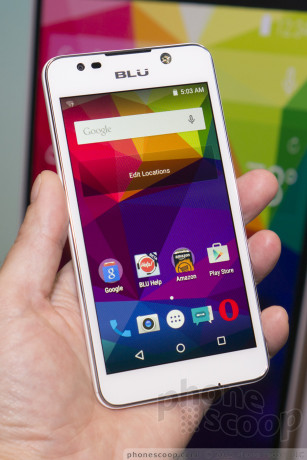
Blu is a fast-growing name in the U.S. phone market. To date, they've focused on selling unlocked phone to be used with T-Mobile and MetroPCS. Now, for the first time, they are offering phones officially certified by T-Mobile, that will be sold by official T-Mobile dealers. This is increasingly important for good LTE service with T-Mobile. The Studio Selfie is the first such phone. We spent some time with it, as well as the incredibly thin Vivo Air and Studio Energy 2 with its massive battery. Read on to find out what they're like in person.
Studio Selfie LTE
Most of Blu's phones to date have had only 3G, or only the most basic support for 4G LTE networks in the U.S.. They haven't supported all of the LTE bands necessary for full coverage and roaming. That's made us hesitant to cover or recommend Blu phones in the past. Also, Blu phones haven't been tested for hearing-aid compatibility, something required of phones sold by carriers.
The Studio Selfie is the first Blu phone to change all of that with its support for LTE band 12, and T-Mobile VoLTE certification. That makes this the first Blu phone to receive full LTE coverage and speed on T-Mobile (or Metro), while also complying with FCC regulations that ensure your ability to place a 911 call reliably. And not only is it tested for hearing aids, it's rated M4/T4, the best rating a phone can have. All of this makes us much more comfortable covering and possibly recommending this phone.
Blu's first round of phones were generic, with a low price being the main selling point. Now, they're expanding to more interesting phones, like a high-end phablet, a super-thin phone, a massive-battery phone, and... a selfie phone.
The Studio Selfie is a $99 Android phone. The "Selfie" part refers to the beefy front camera with its own warm-tone LED flash. But that's pretty much its only claim to fame. It's otherwise a very generic affordable Android phone.
The 5-inch screen is perfectly average. It's not going to impress on sharpness or viewing angle, but I've certainly seen worse. It's a decent display for most people, and for this price range.
The cameras are roughly what you might expect in a $99 phone. The 5-megapixel front camera is decent for a front camera, as one would hope for a phone with Selfie in its name. The 5-megapixel rear camera might actually be worse than the front, which is unusual in any phone. That's based on very limited time with it, but the rear camera certainly did not impress in some quick tests.
The design of the body is above-average for this price range. The front glass fits into its chrome frame nicely. The front has a high-quality appearance to it. The rest of the phone has a rare design that reminds me a bit of the more affordable Lumia phones, with a removable plastic shell that wraps around the sides. It has a very nice soft matte finish that feels nice, makes it easier to grip, and resists fingerprint smudges (to a certain degree.) It's a nice design.
The side keys are a bit flat and flush, but they're comfortable to press and work well.
The software on the Studio Selfie is pretty much standard Android; Blu doesn't customize Android in any meaningful way. The camera is based on the standard Android camera app, but with a friendly options menu and, of course, and enhanced selfie mode.
Affordable Android phones keep getting better, but few reach the $99 price point and offer something extra like good LTE and a decent front camera with flash. This looks like a contender in its price range. We look forward to reviewing it.
Studio Energy 2
The Studio Energy 2 is an affordable Android phone with a really, really huge battery. 5,000 mAh of juice is hiding in this bad boy.
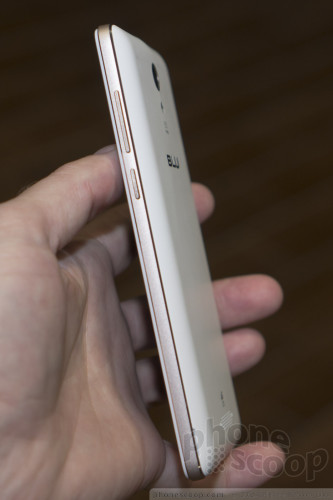
The design is somewhat premium, with an attractive glass front and a metal frame around the sides. The metal frame looks good from a few feet away. But if you look closely, you'll see gaps between the metal and the plastic. This is not actually the injected-plastic design you'll find on higher-end phones from Apple, HTC, and others. But it's a good-enough imitation to fool most of your friends.
The back is rubbery plastic that bulges out to contain the huge battery. The curve of the back plate combined with the warm material make this phone comfortable to hold in spite of its relative thickness.
The side buttons here are thin and sharp, but do work well.
The key feature, of course, is the huge battery. It's big enough to not only power phone for quite a while, but to charge other devices as well. Blu has configured the phone so it can do that, and includes the necessary cable in the box. That's a nice feature. (Huawei has done this on some of its phablets as well.)
The Studio Energy 2 doesn't have band 12, but it does have band 17. That makes this phone better suited to AT&T's network. It lacks band 5, but that's not critical in most places. This phone should provide decent LTE service on AT&T.
Vivo Air LTE
Blu claims the Vivo Air LTE is the thinnest LTE Android phone in the country. After handling one in person, I certainly believe it. It's not the kind of thin you need to measure. Just pick one up, and you'll know. It's impossibly thin and light. "Air" is more than just marketing here, or riding Apple's coattails; Blu engineers really earned the "Air" title with this one.
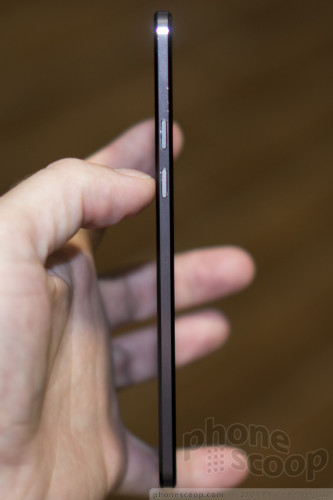
The frame is metal and the front and back are both glass, much like an iPhone 4. But this almost half as thick. Yes, seriously, if you stacked two of these phones together, they would be within one millimeter of the thickness of an iPhone 4. That's insane.
The metal-and-glass design lends it a high-quality feel, although that feeling is offset a bit by the extreme light weight. There is something to be said for the quality feeling of a weighty hunk of metal in your hand.
The buttons are thin and not super comfortable to use, but they work well and look good doing it.
The phone comes in black and white. The all-glass design is a fingerprint magnet, and that shows like crazy on the black version. Fingerprints are far less noticeable on the white version.
Note that the Vivo Air LTE doesn't have band 12, so while it will get basic T-Mobile LTE service, it won't get the full LTE coverage and speed of a phone with band 12. It also lacks band 17, so we wouldn't recommend it for AT&T if you care about decent 4G LTE service. If you're fine falling back to 3G at times, this phone does make quite a style statement.
Comments
No messages













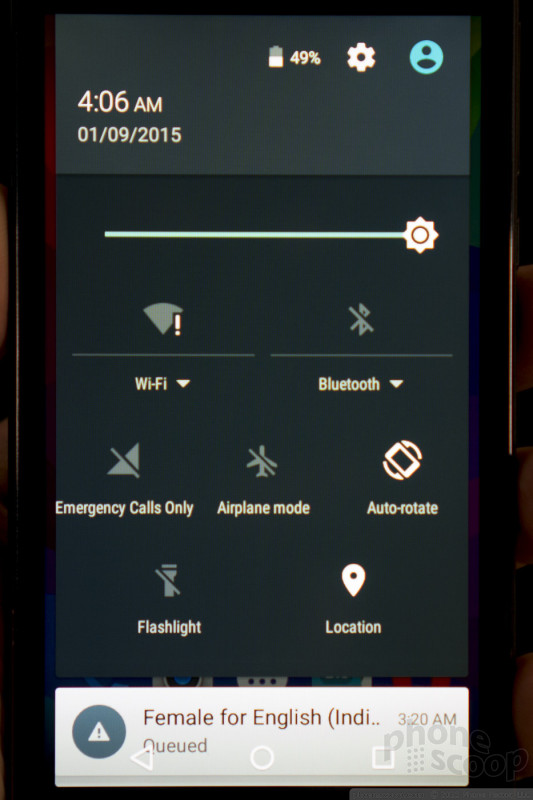

















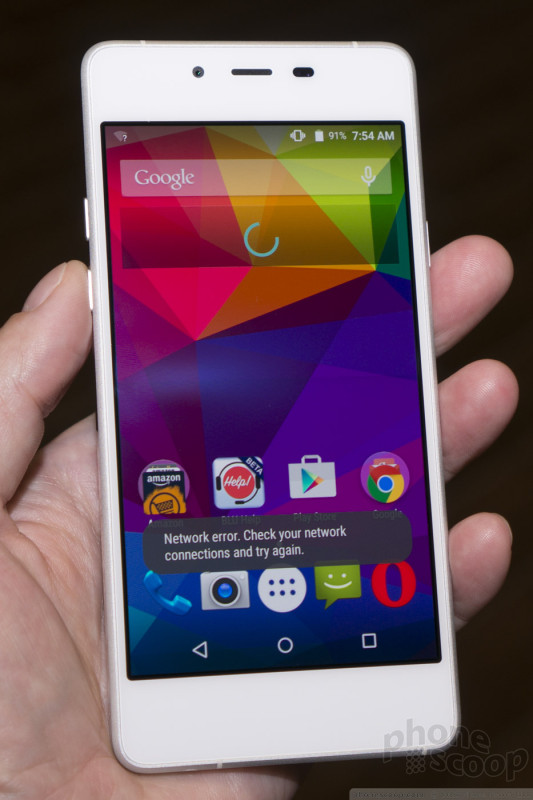
















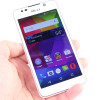 Review: Blu Studio Selfie
Review: Blu Studio Selfie
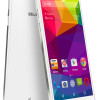 Blu Vivo Air LTE Measures 5.1mm Thick
Blu Vivo Air LTE Measures 5.1mm Thick
 T-Mobile Rolls Out REVVL 8 Pro
T-Mobile Rolls Out REVVL 8 Pro
 Motorola's new Edge Adds Tele Camera, Among Other Upgrades
Motorola's new Edge Adds Tele Camera, Among Other Upgrades
 TCL Brings 5G to its Newest Flip Phone
TCL Brings 5G to its Newest Flip Phone
 BLU Studio Selfie LTE
BLU Studio Selfie LTE








